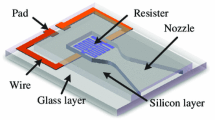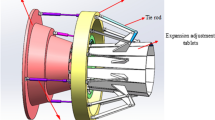Abstract
A coordination control strategy is developed for 3-bearing swivel duct (3BSD) nozzles. A 3BSD nozzle’s deflection angle and direction are changed through rotations of three revolute pairs. There is a nonlinear relationship between the deflection angle/ direction and the rotation angles. The rotation speed of a revolute pair is limited by the power of the actuator. The moment of inertia and the aerodynamic load for each revolute pair are different and time-varying. A high-precision control system of 3BSD nozzles is required for applications on vertical and/or short take-off and landing (V/STOL) aircrafts. Difficulties of coordination control of 3BSD nozzles are distinct travel ranges, speed constraints, time-varying dynamic models, and disturbances. The proposed control strategy is a combination of the characteristic model and the dynamic control allocation method. A dynamic control allocation module is used as the coordination supervisor, which is aware of the kinematic model, the constraints, and the dynamic models of the revolute pairs. Second-order characteristic models are used to represent the dynamic behavior of the revolute pairs. The gradient projection algorithm is modified for parameter estimation. A modified all-coefficient adaptive controller is developed to reject the disturbances. Experimental results of a scaled 3BSD nozzle indicate that the coordination control strategy is effective.
Similar content being viewed by others
References
Yang X L, Fan Y, Zhu J H. Transition flight control of two vertical/short takeoff and landing aircraft. J Guid Control Dyn, 2008, 31: 371–385
Fan Y, Meng X Y, Yang X L, et al. Control allocation for a V/STOL aircraft based on robust fuzzy control. Sci China Inf Sci, 2011, 54: 1321–1326
Neil M. A flexible jet fighter. Innovation, 2009, 10: 21–27
Gregory P W, David A A. X-35B STOVL flight control law design and flying qualities. In: Biennial International Powered Lift Conference and Exhibit, Williamsburg, 2002. 1–13
Maddock I, Hirschberg M. The quest for stable jet borne vertical lift: ASTOVL to F-35 STOVL. In: AIAA Centennial of Naval Aviation Forum “100 Years of Achievement and Progress”, Los Angeles, 2011. 1–16
Walker G, Wurth S, Fuller J. F-35B integrated flight-propulsion control development. In: International Powered Lift Conference, Los Angeles, 2013. 1–15
Mark D B. Highlights of the JSF STOVL jet effects test effort. In: Biennial International Powered Lift Conference and Exhibit, Williamsburg, 2002. 1–16
Wang X Y, Zhu J H, Zhang Y Y, et al. Kinematic modeling and test of the 3-bearing swivel duct nozzle (in Chinese). Acta Aeronaut Astronaut Sin, 2014, 35: 911–920
Allan Y L, Alan S, Rebekah T, et al. Preliminary characterization of the altair lunar lander slosh dynamics and some implications for the thrust vector control design. In: AIAA Guidance, Navigation, and Control Conference, AIAA, Toronto, Canada, 2010. 1–34
Li Y H, Lu H, Tian S L, et al. Posture control of electromechanical-actuator-based thrust vector system for aircraft engine. IEEE Trans Industrial Electronics, 2012, 59: 3561–3571
Koo T J, Li R Q, Quottrup M M, et al. A framework for multi-robot motion planning from temporal logic specifications. Sci China Inf Sci, 2012, 55: 1675–1692
Cui R X, Yan W S, Xu D M. Synchronization of multiple autonomous underwater vehicles without velocity measurements. Sci China Inf Sci, 2012, 55: 1693–1703
Yao Y, Zhang P, Liu H, et al. Optimal switching target-assignment based on the integral performance in cooperative tracking. Sci China Inf Sci, 2013, 56: 1–14
Zhuang Y, Gu M W, Wang W, et al. Multi-robot cooperative localization based on autonomous motion state estimation and laser data interaction. Sci China Inf Sci, 2010, 53: 2240–2250
Wang C S, Li X L, Guo L, et al. A seamless operation mode transition control strategy for a microgrid based on master-slave control. Sci China Tech Sci, 2012, 55: 1644–1654
Tan K K, Lim S Y, Huang S, et al. Coordinated motion control of moving gantry stages for precision applications based on an observer-augmented composite controller. IEEE Trans Control Syst Tech, 2004, 12: 984–991
Gan Y H, Dai X Z. Survey of coordinated multiple manipulates control. Control Decision, 2013, 28: 321–333
Zhang W H, Qi N M, Ma J, et al. Neural integrated control for a free-floating space robot with suddenly changing parameters. Sci China Inf Sci, 2011, 54: 2091–2099
Gracia L, Sala A, Garelli F. Robot coordination using task-priority and sliding-mode techniques. Robot Comput Integrat Manuf, 2014, 30: 74–89
Rubrecht S, Padois V, Bidaud P, et al. Motion safety and constraints compatibility for multibody robots. Autonom Robots, 2012, 32: 333–349
Parker L E. Distributed intelligence: Overview of the field and its application in multi-robot systems. J Phys Agents, 2008, 2: 5–14
Sen S, Ray G, Ghoshal T K. Dynamic control allocation for tracking time-varying control demand. J Guid Control Dyn, 2008, 31: 1150–1157
Luo Y, Serrani A, Yurkovich S, et al. Model predictive dynamic control allocation with actuator dynamics. In: American Control Conference, Boston, 2004. 1695–1700
Luo Y, Serrani A, Yurkovich S, et al. Dynamic control allocation with asymptotic tracking of time-varying control trajectories. In: American Control Conference, Portland, 2005. 2098–2103
Wu H X, Wu J, Xie Y C. Intelligent Adaptive Control Based on Characteristic Model (in Chinese). Beijing: Chinese Science and Technology Press, 2009. 76–78
Zhang Z, Hu J. Stability analysis of a hypersonic vehicle controlled by the characteristic model based adaptive controller. Sci China Inf Sci, 2012, 55: 2243–2256
Wu H X, Hu J, Xie Y C. Characteristic model-based all-coefficients adaptive control method and its applications. IEEE Trans Syst Man Cyb, 2007, 37: 213–221
Hu J. All-coefficient adaptive reentry lifting control of manned spacecraft (in Chinese). J Astronaut, 1998, 19: 8–12
Meng B, Wu H X, Lin Z L, et al. Characteristic model based control of the X-34 reusable launch vehicle in its climbing phase. Sci China Inf Sci, 2009, 52: 2216–2225
Li H B, Sun Z Q, Min H B, et al. Fuzzy dynamic characteristic modeling and adaptive control of nonlinear systems and its application to hypersonic vehicles. Sci China Inf Sci, 2011, 54: 460–468
Wu H X, Liu Y W, Liu Z H, et al. Characteristic modeling and the control of flexible structure. Sci China Ser E-Inf Sci, 2001, 31: 137–149
Yang J C, Hu J, Ni M L. Adaptive guidance law design based on characteristic model for reentry vehicles. Sci China Inf Sci, 2008, 51: 2005–2021
Zhou C J, Shi Y F, Yang S H. Characteristic model-based adaptive discrete-time sliding mode control for the swing arm in a Fourier transform spectrometer. IEEE Trans Syst Man Cyb C: Appl Rev, 2012, 42: 1633–1643
Leung S H, So C F. Gradient-based variable forgetting factor RLS algorithm in time-varying environments. IEEE Trans Sig Proc, 2005, 53: 3141–3150
Felix A. Improved variable forgetting factor recursive least square algorithm. In: 12th International Conference on Control, Automation, Robotics Vision, Guangzhou, 2012. 1789–1793
Chen J, Ma T, Chen W J, et al. Unsupervised robust recursive least-squares algorithm for impulsive noise filtering. Sci China Inf Sci, 2013, 56: 1–10
Author information
Authors and Affiliations
Corresponding author
Rights and permissions
About this article
Cite this article
Wang, X., Zhu, J., Yang, J. et al. Coordination control strategy based on characteristic model for 3-bearing swivel duct nozzles. Sci. China Technol. Sci. 57, 2347–2356 (2014). https://doi.org/10.1007/s11431-014-5703-1
Received:
Accepted:
Published:
Issue Date:
DOI: https://doi.org/10.1007/s11431-014-5703-1




